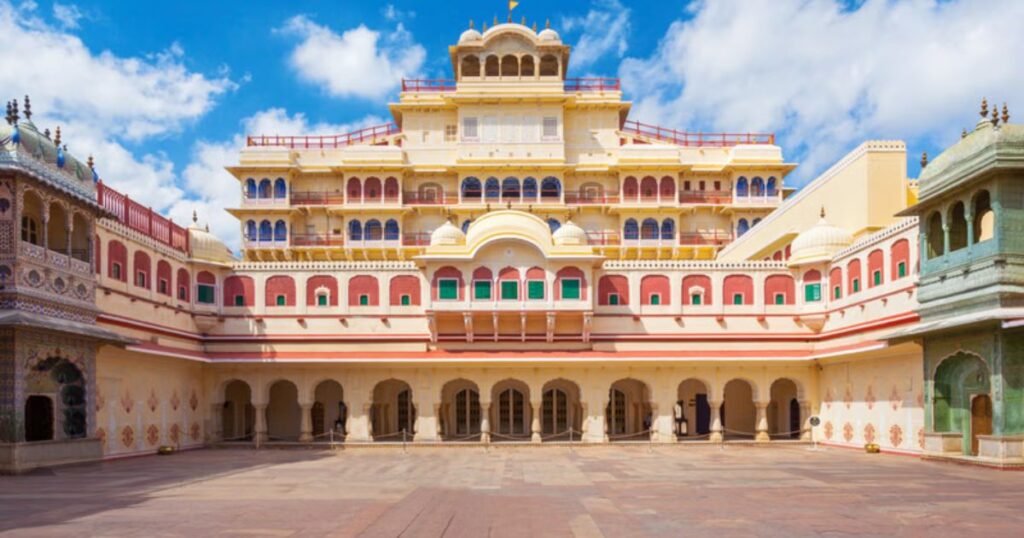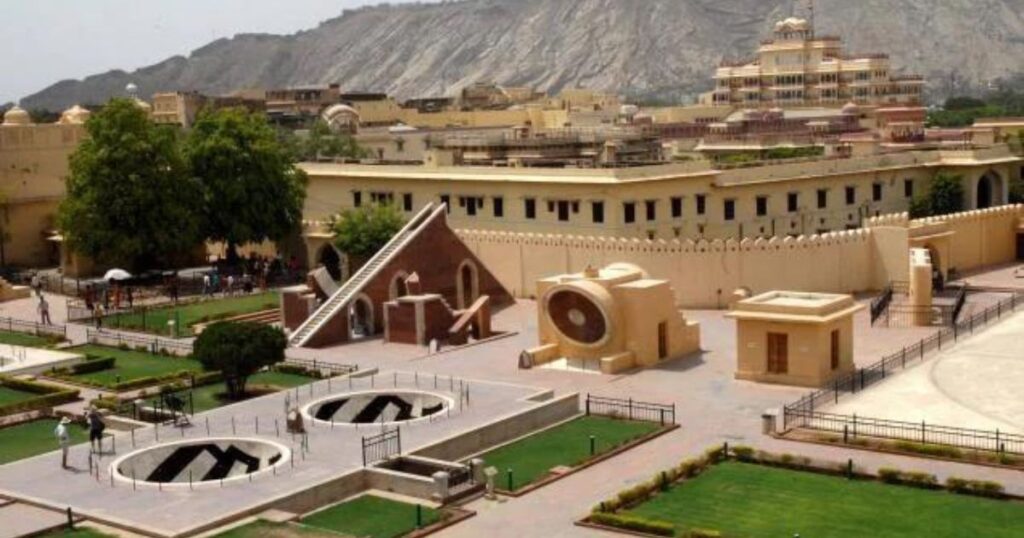In the Indian city of Jaipur, Sindhi Camp is both a busy transportation hub and a lively area. There are many cars ready to take tourists all over Rajasthan and beyond, so they can really experience the real hustle and bustle of Indian life. Within the area around Sindhi Camp, there are many winding streets lined with cheap places to stay and a wide range of delicious foods, giving visitors a taste of everyday Jaipur’s beauty.
Even though Sindhi Camp isn’t very well known among tourists, it’s easy to get to Jaipur’s most famous sights. Just a short distance away, people can learn about the area’s rich past and see its beautiful architecture at places like the Amer Fort and the Hawa Mahal. The luxurious City Palace and the amazing astronomical sights of Jantar Mantar are also waiting to be explored, making Sindhi Camp an even better place to stay for activities in Jaipur.
There are a lot of different places to stay in Sindhi Camp, so travelers can find something that fits their price and tastes. Sindhi Camp is a colorful fabric where you can find something for everyone, from cozy guesthouses to high-end hotels. Sindhi Camp’s great location and wide range of services make it a great place to stay for people starting their trip through the heart of Jaipur.
The Transport Hub
In the middle of all the people, look for information booths or staff members to help you find your way around Sindhi Camp Bus Station. There are ticket counters for many routes, so make sure you have your ID and travel papers on hand. Watch the departure boards or ask a worker to help you find your bus stop in the middle of all the other people in the station.
If you have a lot of heavy bags, you might want to hire a porter to help you find your bus among all the other people. Some bus stops, like Sindhi Camp, have lockers where you can store your bags while you’re in Jaipur. Get drinks and snacks from the station’s cafes and sellers, but be careful about food safety, especially when it’s hot outside.
If you want a smooth trip, get to the bus stop early, especially during busy times or on popular routes. When someone offers to help, be wary of them and instead ask government staff for help. Bring cash with you for small purchases, and if you need to, download apps that can help you find bus times and translate words. Enjoy the lively atmosphere of Sindhi Camp Bus Station as you start your trip through Rajasthan.
The Neighborhood
In the area around Sindhi Camp, travelers on a budget can choose from a range of options, including guesthouses and hostels, which offer a social setting great for meeting other travelers. For a more immersive experience, stay with a local family in their home. This will give you a chance to learn about Rajasthani culture and daily life.
Start your culinary adventure in Sindhi Camp by trying tasty treats from street sellers, drinking chai in secret cafes, and eating delicious Rajasthani food at local restaurants. Everyone can find something they enjoy, whether it’s street food, secret cafes, or traditional Rajasthani food.
Go off the beaten path and check out lively local markets full of colorful clothes and fragrant spices. You can also find secret temples and shrines and relax in public parks in the middle of the city’s energy. Dive into the heart of Sindhi Camp’s neighborhood to find its culturally rich and secret gems.
Learning a few simple Hindi phrases will help you get along better with locals, show respect for their culture, and start friendly conversations. Allow yourself to relax, slow down, and enjoy the easy pleasures of daily life in Sindhi Camp, where life moves more slowly than in the city. Explore the colorful tapestry of Sindhi Camp to learn more about Jaipur’s soul and make moments that will last a lifetime.
Things to Do in the Area
Even though Sindhi Camp doesn’t have many tourist draws on its own, its location makes it easy to get to Jaipur’s most famous sites. Here are a few important highlights:
· Amer Fort:
The UNESCO World Heritage Site Amer Fort is known for its large complex of palaces, temples, and gardens. It gives tourists a look into Rajasthan’s royal history. It is only 11 kilometers from Sindhi Camp and can be reached by cab, auto rickshaw, or private car. This makes it a great place to go for a day trip from Jaipur.
Raja Man Singh I built Amer Fort in 1592. Its grand courtyards, intricate carvings, and stunning frescoes are a mix of Rajput and Mughal architectural styles that captivate tourists. The Suraj Pol, Diwan-i-ᤏ, Sheesh Mahal, and Mughal Gardens are some of the most impressive parts of the fort. Each gives you a different view of its beauty.

In addition to its amazing architecture, Amer Fort has a fascinating light and sound show, elephant rides that you can choose to take, and stunning views of Maota Lake and the Aravalli Hills. People who want to visit the fort can think about when it’s open, how much it costs, and whether they want to hire certified guides to learn more about its past and hidden details.
· Hawa Mahal (Palace of Winds):
The Hawa Mahal, also known as the Palace of Winds, is a stunning piece of architecture in Jaipur. It was made from bright red and pink sandstone. Its complicated layout, with 953 small openings called Jharokhas, lets cool air flow through naturally, providing a welcome break from the desert heat. It’s a must-see in Jaipur and only a short distance from Sindhi Camp. Its fairy tale-like beauty will enchant tourists.
When it was first built in the late 18th century as an addition to the City Palace, Hawa Mahal was a place where royal women in purdah could watch street processions without being seen. Its beautiful windows gave views of Jaipur’s busy life, which added to the palace’s beauty and historical importance. Explore the palace’s Rajput and Mughal styles, including its domed canopies and elaborate stone inlay work, both inside and out. Be amazed by the palace’s grandeur.

Planning a trip to Hawa Mahal is easy, and it’s easy to get there from Sindhi Camp by cab, auto rickshaw, or even on foot. Usually, the palace is open from 9:00 AM to 4:30 PM. Indian citizens and foreign guests have to pay different fees to enter. Early in the morning or late in the afternoon are the best times to see the pink wall and take pictures of it because the light is so nice. After seeing how beautiful and royal Hawa Mahal is, go back to Sindhi Camp to enjoy the busy local markets and tasty street food, which are a great contrast to the palace’s formal atmosphere.
· City Palace:
The City Palace in Jaipur is more than just a palace; it’s a huge building that shows how grand and historic the city is. It is about 5 kilometers from Sindhi Camp and is a must-see for anyone interested in Rajasthan’s royal history.

A Fusion of Architectural Marvels:
When work on the City Palace started in the late 1700s, it was an interesting mix of different architectural styles from over two hundred years. Mughal styles can be seen in the use of marble and elaborate floral designs. Rajput styles can be seen in the use of bright colors and geometric shapes. The Pitam Niwas Chowk, Chandra Mahal, Mubarak Mahal, Diwan-e-aam, and Diwan-i-Khas are some of the most interesting parts of the palace that people will see as they walk around.
A Glimpse into Royal Life:
The royal apartments in the City Palace are filled with beautiful paintings, intricate carvings, and luxurious furniture that give visitors a glimpse into the lives of Jaipur’s past rulers. As people walk through these historic rooms, they can picture how grand life was at the royal court.
Planning Your Visit:
The City Palace is open from 9:30 AM to 5:00 PM, but different parts of it are open at different times. There are different entry fees for Indian citizens and tourists from other countries. Some places, like the Chandra Mahal, also charge extra. To learn more about the palace’s past and importance, you might want to rent audio guides or go on a guided tour. Also, there isn’t a strict dress rule, but covering your shoulders and knees is a good idea for respect.
Jantar Mantar:
Jantar Mantar in Jaipur isn’t like most museums; it’s an open-air astronomy observatory with huge tools for looking up at the stars without a telescope. It’s only about 4 kilometres from Sindhi Camp and is a unique and interesting place to visit for anyone interested in science, history, or just something out of the ordinary.

A Legacy of Astronomical Genius:
Maharaja Sawai Jai Singh II, an avid scientist and mathematician, built Jantar Mantar in the early 18th century. It is a testament to his vision and creativity. His collection of tools, which are made to make accurate observations of the sky, shows how much he wants to advance the study of the universe.
Marvel at the Instruments:
The Jantar Mantar is home to many huge instruments, each with a unique job in measuring things that happen in space. Highlights include the Samrat Yantra, the world’s largest sundial, and the Jantar Yantra, a giant quadrant instrument. As people look around these huge structures, they are asked to imagine the important science discoveries that they made possible hundreds of years ago.
A Journey Beyond Instruments:
Beyond its physical structures, Jantar Mantar represents how people want to learn about and understand the world. When people stand in front of these instruments, they can feel the spirit of scientific study that went into making them. This gives visitors a deep connection to the history of astronomy and to the human desire to know more.
Planning Your Visit:
Jantar Mantar is usually open from 9 AM to 4:30 PM, and Indian citizens and foreign guests pay different amounts to enter. You might want to hire a qualified guide to learn more about the science behind each instrument. After seeing the amazing sights at Jantar Mantar, tourists can go back to Sindhi Camp to experience Jaipur’s lively culture, which is a nice contrast to the celestial sights they’ve seen.
Where to Stay
There are many affordable places to stay in Sindhi Camp, from guesthouses and hostels to cheap hotels, so travellers on a tight budget can still have a comfortable stay. These places to stay have simple amenities and a social vibe that makes it easy to meet other travellers and share stories. No matter if you’re travelling by yourself or with a partner, Sindhi Camp has something for every style and price.
When picking a place to stay in Sindhi Camp, you should think about your income, how you like to travel, and what amenities you want. You can choose the amount of comfort and ease of use that works best for you since there are options that won’t break the bank. Sindhi Camp has rooms that can be changed to fit your needs, whether you want to be around other people or be alone.
If you want a more opulent experience, the areas around Jaipur have high-end hotels and resorts with lots of nice services and beautiful scenery. With spas, swimming pools, and high-end restaurants, these places to stay offer a peaceful escape from the noise and chaos of the city. With Sindhi Camp as your home base, you can enjoy the pleasures of luxury while still being close to everything.
You can get the best of both worlds during your time in Jaipur by staying in Sindhi Camp and going to other places with nicer services and more luxurious settings. No matter what kind of accommodations you choose—low-cost ones or high-end ones—careful planning and study will make sure you have a comfortable and memorable stay. You can choose an accommodation that fits your tastes and price from a range of options, making sure you have a great time in the heart of Jaipur.
Tips for Travelers
- Enjoy the busy and exciting environment of Sindhi Camp Bus Station; it’s part of the fun of travelling in India.
- Keep an eye on your things and ask for help at information booths or from staff to make the trip go smoothly.
- Get there early and make plans ahead of time to avoid problems getting on the bus at the last minute.
- Spend your time enjoying the many tasty street foods in Sindhi Camp, but make sure you stay safe by picking vendors with a steady flow of customers and meals that are just made.
- Don’t forget to bring cash, since many street sellers might not take cards.
- Check out the markets near Sindhi Camp and follow the custom of haggling for one-of-a-kind things.
- Be polite during negotiations, make a list of your spending limits before you start, and enjoy talking with sellers.
- Use rickshaws as an easy way to get around Sindhi Camp, but make sure you can communicate clearly and agree on prices ahead of time.
- Get an idea of how much the trip usually costs, and be polite when you bargain with the motorbike drivers.
- Use rickshaws to get around the area because they are cheap and easy to use.
- If you want to get the most out of Sindhi Camp and beyond, learn some simple Hindi phrases like “Namaste” and “Dhanyavad.”
- By greeting people in a way that shows respect for their culture, you can start a nice conversation with them.
- If you follow these tips, you’ll be able to confidently find your way around Sindhi Camp, enjoy the local vibe, and find the heart of Jaipur’s wonders.
Read More: Abbottours.com
